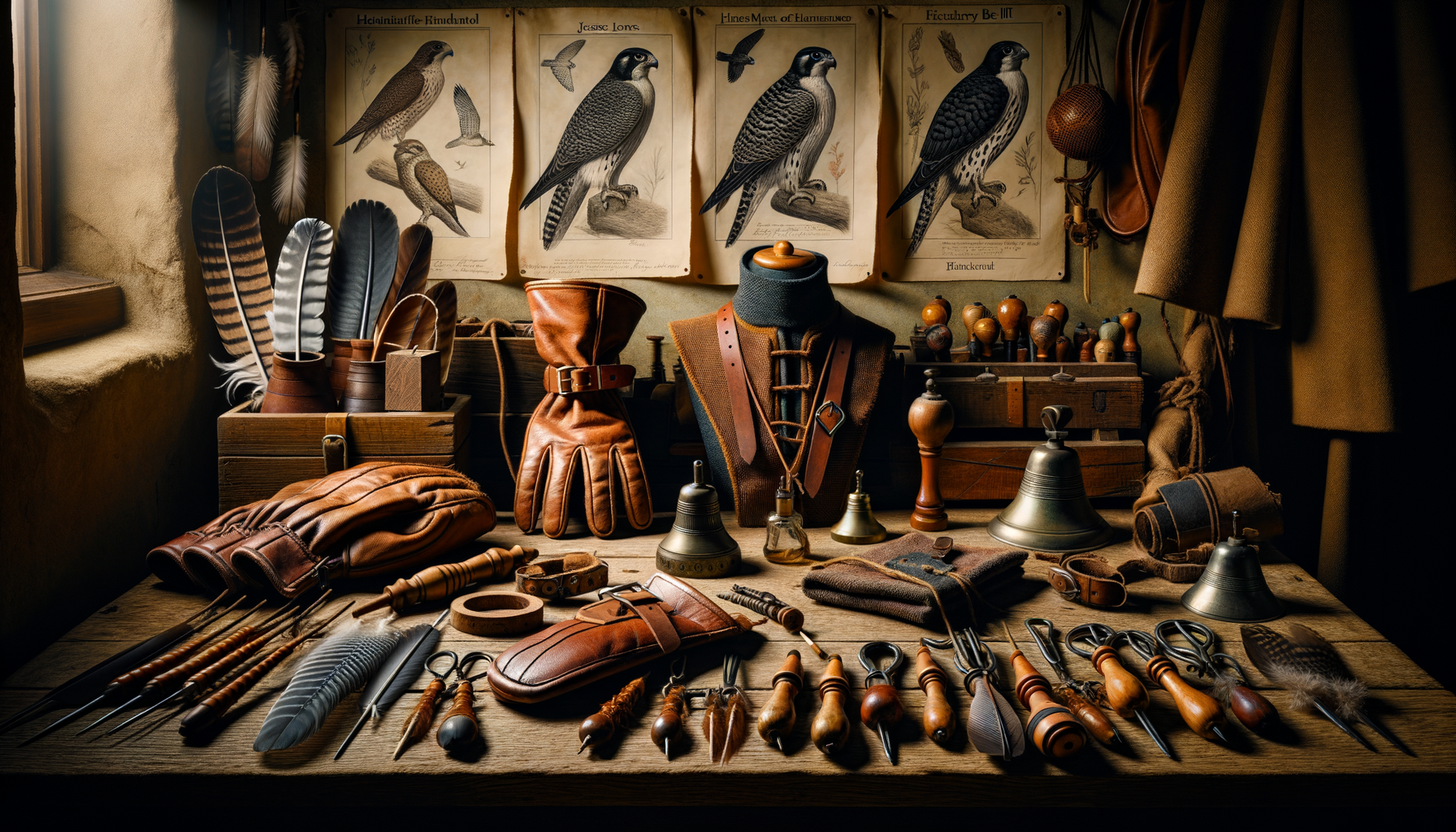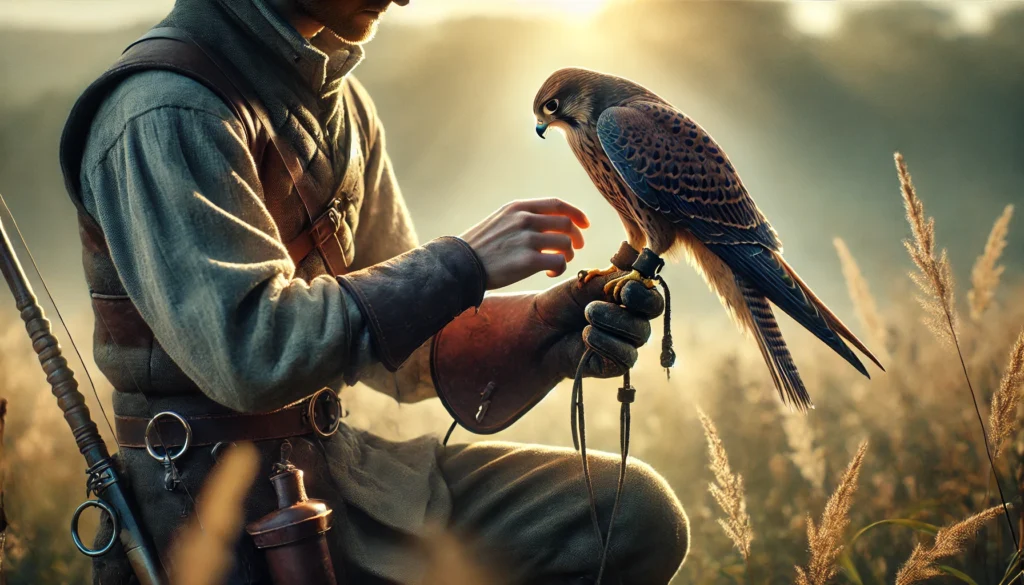Essential Tips for Homemade Falconry Equipment
- Importance of Quality and Safety: Always prioritize high-quality materials to ensure the safety and well-being of both the falconer and the bird.
- Basic Equipment Needed: Key items include a glove, jesses, leashes, anklets, hoods, and perches. Each plays a crucial role in falconry.
- Crafting Your Own Glove: Use thick, durable leather to protect your hand and ensure it extends far enough up the wrist to prevent injuries.
- Creating Jesses and Leashes: Opt for strong, lightweight leather or synthetic materials. Proper length and strength are crucial for the bird’s comfort and control.
- Anklets and Bells: Ensure the anklets are well-fitted and secure. Bells help to locate the bird, so they should be sturdy and not too large.
- Making a Hood: A well-fitted hood is vital for the bird’s calmness. It should be snug but not too tight, made from breathable materials.
- Building Perches: These should be stable and comfortable for the bird’s feet. They need to be high enough to give the bird a good view and sense of security.
- Regular Maintenance: Regularly check and maintain all equipment for wear and tear to ensure it remains safe and functional for your bird.
- Customization: Personalize your equipment to fit the needs and preferences of your bird ‘ every detail matters in keeping your bird comfortable and secure.
Discovering the Magic of Homemade Falconry Equipment
Hello, fellow falconry enthusiasts! Let’s embark on a journey through the enchanting world of homemade falconry equipment together. Imagine you’re in the lush, rolling hills of Ireland, where each falconer crafts their tools with as much care and attention to detail as they would knit a cozy woolen sweater. Here at Learn Falconry, we believe that making your own equipment can be just as rewarding as flying a majestic falcon itself.
Why should you keep reading, you ask? Well, think of this article as your personal map, guiding you to crafting your own unique falconry equipment. Just like the skilled hands of an Irish storyteller weaving tales that captivate your imagination, we’ll show you how to create functional, durable, and personalized gear that will make your falconry experience truly unforgettable.
By delving into the art of homemade equipment, you’ll not only save money but also gain a deeper connection with the ancient craft of falconry. So, grab a cup of tea, settle in, and let us guide you through the traditional and modern techniques of creating your very own falconry tools. Your feathered friend deserves the best, and crafting these pieces yourself ensures that every knot, stitch, and hard-earned detail is just right.
Crafting Homemade Falconry Equipment: A DIY Guide
Welcome to Learn Falconry, where we embrace the art and tradition of falconry. One of the exciting aspects of this ancient practice is the ability to craft your own DIY falconry gear. Not only does this save on costs, but it also allows for a deep, hands-on connection with your falconry equipment, making the experience even more rewarding.
Choosing Materials for DIY Falconry Gear
When crafting homemade falconry tools, selecting the right materials is fundamental. Leather is a popular choice for many pieces of equipment, including gloves, jesses, and hoods. It’s essential to use durable, high-quality leather to ensure the safety and comfort of your falcon. Metal and strong fabrics can also be used for parts that require extra strength, like leashes and perches. For a detailed overview of falconry history and equipment, check out our history of falconry and falconry equipment sections.
Crafting Falconry Gloves
Falconry gloves, known as gauntlets, are an essential part of a falconer’s kit. They protect your hand from the sharp talons of your bird. To craft your own, you will need a pattern, high-quality leather, and basic sewing tools. Ensure that the glove fits comfortably and allows you to handle your falcon without restrictions. Learn more about different types of falconry gloves and their uses.
Making Jesses and Leashes
Jesses are small straps that attach to your falcon’s legs, allowing you to control and retrieve them as needed. Leashes connect to the jesses and must be strong enough to withstand sudden pulls but light enough to not discomfort the bird. Properly crafted jesses and leashes are vital for training and safety. For more detailed instructions on jesses and leashes, visit our jesses and leashes guide.
Building Perches and Stands
A good perch is crucial for your falcon’s comfort and health. You can easily make one at home using sturdy materials like wood and rope. Perches should be stable and have a comfortable surface where the falcon can grip without causing foot injuries. Explore the various types of perches and stands to find the perfect fit for your setup.
Crafting Falconry Hoods
Hoods are used to cover the falcon’s eyes, keeping it calm during transport or while it’s not hunting. Crafting a hood involves precise measurements to ensure it fits properly without causing stress or injury to the bird. Patterns and tutorials are available to help you create a custom hood for your falcon. Learn about the different types of hoods and their applications.
Making Lures
Lures are used in training to mimic the falcon’s prey and encourage desired behaviors. You can make effective lures at home using materials like leather, feathers, and small animal parts. The key is to create something that will entice the falcon to respond as it would in the wild. See our guide on falconry lures for more tips.
Legal Aspects of Crafting Falconry Equipment
It’s important to note that crafting your own falconry equipment must adhere to local and international falconry regulations. Proper documentation and knowledge of these legal aspects ensure that you practice falconry ethically and legally. Make sure to familiarize yourself with falconry legal requirements to avoid any legal issues.
Training with Your Homemade Equipment
Once you’ve crafted your items, it’s time to test them out. Training sessions will reveal if any adjustments are needed. Crafting your own gear gives you the flexibility to tailor each item to your falcon’s specific needs, enhancing both training and performance. For more on training techniques, visit our training a falcon section.
Creating your own falconry equipment can be a fulfilling journey that ties you closer to the rich tradition of falconry. Dive into this hands-on experience and start crafting today!
Exploring Homemade Falconry Equipment
Welcome to the fascinating world of homemade falconry equipment! This guide will show you how to craft your own falconry tools using various materials and techniques. Let’s dive into the intricate craftsmanship and essential components of creating high-quality gear for your falcons.
Materials Used in Crafting
Crafting homemade falconry equipment involves the use of durable materials like leather, nylon, and metal. These materials are chosen for their strength, flexibility, and ability to withstand the wear and tear of handling birds of prey.
- Leather: Often used for gloves, jesses, and anklets. High-quality leather is essential for providing comfort and protection.
- Nylon: Used for certain straps and components that require elasticity and durability.
- Metal: Utilized for making swivels, eyelets, and other hardware components.
| Material | Used For | Properties |
|---|---|---|
| Leather | Gloves, Jesses, Anklets | Strong, flexible, long-lasting |
| Nylon | Straps, Leashes | Elastic, durable, lightweight |
| Metal | Swivels, Eyelets, Hardware Components | Robust, corrosion-resistant |
Types of Gear
Essential falconry gear includes jesses, hoods, leashes, and swivels. Each piece of equipment is designed to be robust and versatile, catering to various bird sizes and handling techniques.
- Gloves: Made to protect the falconer’s hand; often customized with different stitching and lining colors.
- Anklets: Provide comfortable and secure attachment points on the bird’s legs.
- Jesses: Connect the falcon to the falconer or a perch.
- Leashes and Swivels: Allow the bird to be tethered safely while offering freedom of movement.
| Gear Type | Description | Customization Options |
|---|---|---|
| Gloves | Protective wear for the falconer’s hand | Stitching, lining colors |
| Anklets | Secure leg attachments | Sizes, materials |
| Jesses | Connects falcon to falconer or perch | Stitching, color |
| Leashes | Tethers the bird with freedom of movement | Length, material |
| Swivels | Allows rotation and movement without tangling | Metal types, sizes |
Craftsmanship and Customization
Quality and safety are paramount in the design and construction of falconry gear. Craftsmen employ techniques like braiding and layering to produce strong and flexible components capable of withstanding a bird of prey’s power. Additionally, customization allows falconers to tailor the gear according to their personal preferences and their bird’s unique needs.
- Braiding and Layering: Increases strength and flexibility.
- Custom Adjustments: Enables precise fitting and added features.
| Crafting Technique | Purpose | Benefits |
|---|---|---|
| Braiding | Strengthens and enlarges jesses and leashes | Enhanced durability |
| Layering | Increases the strength and comfort of gloves | Prevents wear and increases longevity |
| Custom Adjustments | Tailors gear to specific needs | Personalized fitting |
Portability and Maintenance
Falconry gear is designed to be portable, making it easy for falconers to carry and transport their equipment. Maintaining the gear involves regular cleaning, conditioning, and repair to ensure it remains functional and durable.
- Portability: Lightweight and easy to transport.
- Maintenance: Regular care with leather dressing and tool repairs keeps equipment in top condition.
| Aspect | Detail | How It Helps |
|---|---|---|
| Portability | Lightweight, easy to carry | Convenient for travel |
| Maintenance | Regular cleaning, conditioning, repair | Ensures durability and effectiveness |
Essential Tools and Accessories
Several tools and accessories are vital for crafting and maintaining falconry equipment. These include cutting mats, eyelets and pliers, punches, thread, and instructional resources.
- Cutting Mats: Self-healing mats that extend blade life.
- Eyelets and Pliers: Available in various sizes for different eyelet placements.
- Punches: Heavy-duty punch pliers for leather crafting.
- Thread: Durable thread suitable for leather stitching.
| Tool Type | Use | Benefits |
|---|---|---|
| Cutting Mats | Protects surfaces, extends blade life | Longevity for crafting tools |
| Eyelets and Pliers | Secures eyelets in leather | Enhanced durability |
| Punches | Creates holes in leather | Precise, easy hole-making |
| Thread | Stitches leather components | Strong, durable seams |
By understanding the materials, types of gear, craftsmanship techniques, portability, maintenance, and essential tools, you can dive into the art of creating your own falconry equipment. Happy crafting!
Wrapping Up: Crafting Your Own Falconry Gear
Creating your homemade falconry equipment in 2024 is both rewarding and practical. By using durable materials such as leather, nylon, and metal, you can craft essential items like gloves, jesses, hoods, leashes, and swivels that are strong, flexible, and reliable. Customization is key, as it allows you to tailor your gear to your specific needs and personal preferences.
In addition to personalization, DIY falconry gear is designed for durability and portability, making it a perfect fit for falconers on the go. Regular maintenance with special leather dressings and care tips will ensure your equipment’s longevity and performance.
Remember, attention to detail and quality craftsmanship are crucial when making falconry tools. Whether you’re customizing stitching colors, adjusting sizes, or selecting high-quality, natural materials, every detail contributes to creating functional and aesthetically pleasing gear.
By following these guidelines and putting in the effort, you’ll not only save money but also gain a deeper connection with the art of falconry. Happy crafting, and may your falconry adventures be safe and exhilarating!



